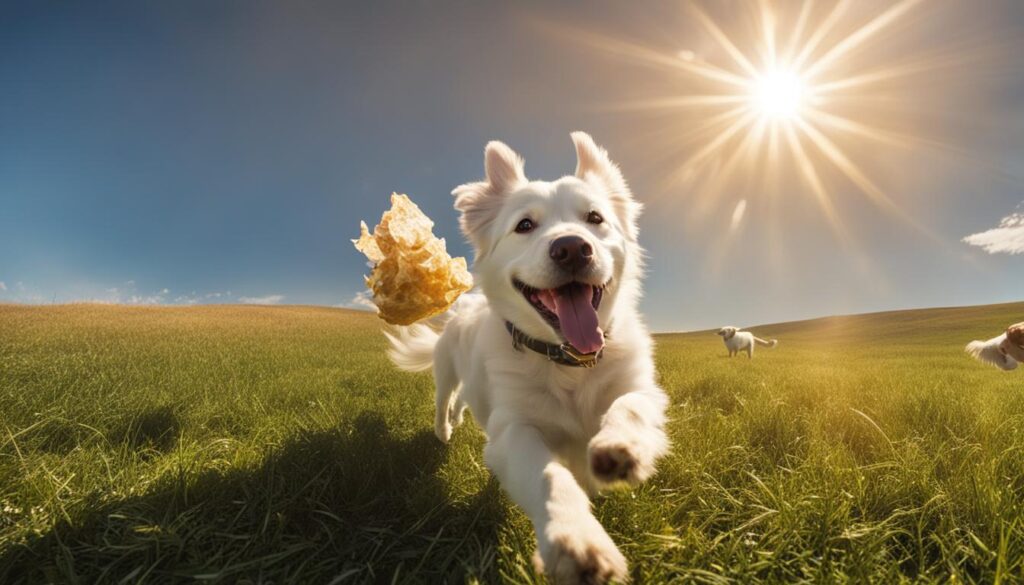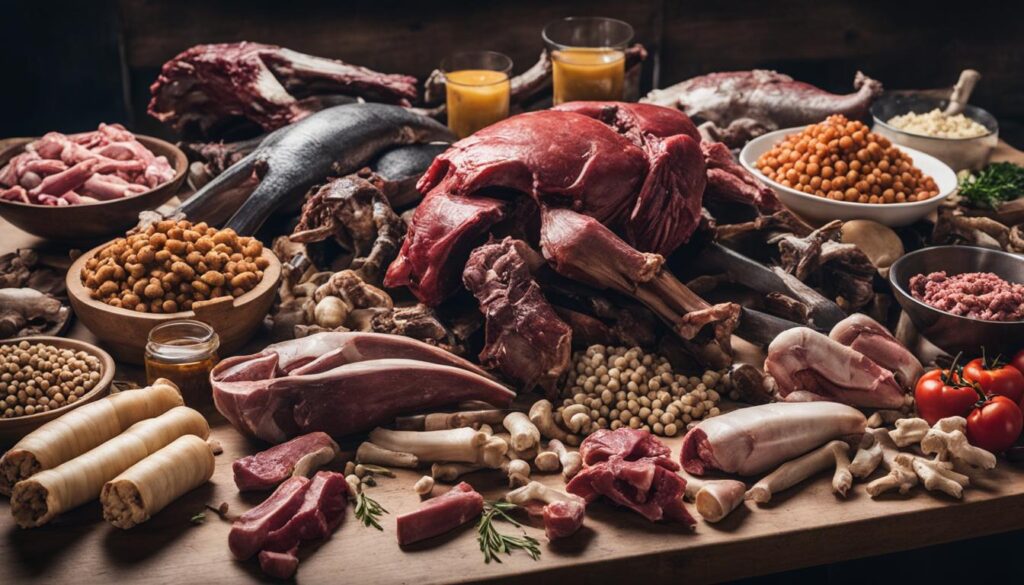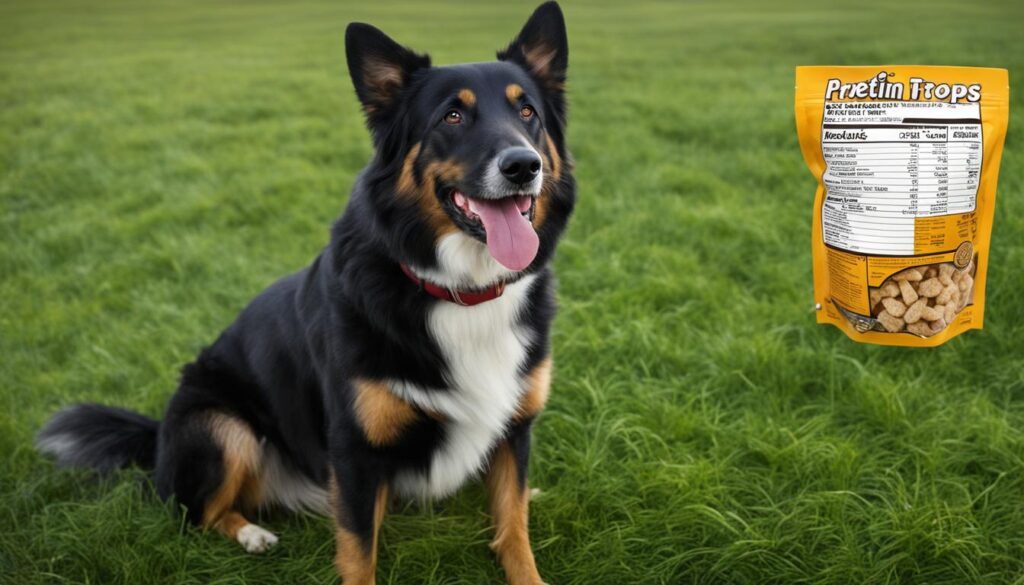When it comes to feeding our furry friends, it’s essential to consider their nutritional needs and safety. One common question that arises is whether dogs can safely eat pork rinds. To provide expert insights on this topic, I’ve delved into the research and consulted with professionals in the field.
According to a study published in the Journal of Animal Science, expanded pork skin chews, which are similar to pork rinds, are highly digestible for dogs. The study found that gastric digestibility of expanded pork skin chews increased over time, reaching near complete digestibility in the gastric plus small intestinal phase. In vivo digestibility of dry matter and other nutrients was also greater when dogs were fed expanded pork skin chews. These findings suggest that pork rinds, when consumed in moderation, can be safe for dogs to eat.
Key Takeaways:
- Expanded pork skin chews, similar to pork rinds, are highly digestible for dogs.
- Pork rinds can be safe for dogs to eat when consumed in moderation.
- Pork rinds are a good source of protein for dogs.
- However, it’s important to note that pork rinds are high in fat and sodium, so they should only be given to dogs in moderation as an occasional treat.
- Consult with your veterinarian to determine the best treats for your dog’s individual needs and dietary restrictions.
The Nutritional Value of Pork Rinds for Dogs

Pork rinds offer several health benefits for dogs and can be a valuable addition to their diet. They provide a good source of protein, essential amino acids, and minerals that support muscle development, repair, and overall health. However, it’s crucial to consider the high fat and sodium content of pork rinds. Therefore, they should only be given to dogs in moderation and as an occasional treat.
Pork rinds contribute to canine nutrition in the following ways:
- Protein Source: Pork rinds are rich in protein, which is vital for dogs to build and maintain muscle mass.
- Amino Acids: They contain essential amino acids that support various biological functions, including tissue repair and immune system function.
- Minerals: Pork rinds are a good source of minerals such as iron and zinc, which are crucial for a dog’s overall health and well-being.
While the nutritional value of pork rinds is undeniable, it’s essential to note that they are high in fat and sodium. Therefore, they must be given to dogs sparingly. Moderation is key to prevent weight gain and other potential health issues. As with any treats, it’s always best to consult with your veterinarian to ensure that pork rinds fit well within your dog’s dietary needs and restrictions.
Potential Risks and Precautions of Feeding Pork Rinds to Dogs

Although pork rinds can be safe for dogs to eat, it is important to be aware of potential risks and take necessary precautions. Feed pork rinds to dogs in moderation to avoid health issues associated with their high fat and sodium content. Obesity and other complications can arise if dogs consume pork rinds in large quantities.
Furthermore, some dogs may have difficulty digesting pork rinds, which can result in gastrointestinal upset. It is crucial to monitor your dog’s response to pork rinds and discontinue feeding them if any digestive issues occur.
To ensure the safety of your canine companion, it is essential to select plain pork rinds that do not contain any seasonings or flavorings that may be harmful to dogs. Ingredients such as onion or garlic powder can be toxic to dogs, so it is important to check the label and opt for plain pork rinds to avoid any potential harm.
Potential Risks of Feeding Pork Rinds to Dogs:
- Increase in fat and sodium intake, leading to obesity and other health issues
- Gastrointestinal upset and digestive difficulties
- Possible ingestion of harmful seasonings or flavorings
Remember, consulting with a veterinarian is always recommended before introducing any new food to your dog’s diet. They can provide personalized advice based on your dog’s specific needs and dietary restrictions.
| Nutrient | Pork Rinds | Dog Treat A | Dog Treat B |
|---|---|---|---|
| Protein | 37g | 20g | 15g |
| Fat | 54g | 10g | 8g |
| Sodium | 980mg | 200mg | 150mg |
| Calories | 604 | 300 | 250 |
Alternatives to Pork Rinds for Dogs

If you’re looking for alternative treats for your dog, there are plenty of dog-friendly options available. Many pet stores offer a wide range of treats specifically formulated for dogs, including treats made from other types of meat or plant-based ingredients. Some examples of dog-friendly treats include jerky treats, dental chews, and freeze-dried meat treats. It’s always a good idea to consult with your veterinarian to determine the best treats for your dog’s individual needs and dietary restrictions.
| Treat Name | Ingredients | Nutritional Value |
|---|---|---|
| Jerky Treats | Chicken, beef, or turkey | Protein-rich, low fat |
| Dental Chews | Vegetable-based or natural ingredients | Promote dental health, low calorie |
| Freeze-Dried Meat Treats | Single-ingredient: chicken, beef, or fish | High protein, no preservatives or additives |
These alternatives provide a variety of flavors and textures for your dog to enjoy, while also offering nutritional benefits. Remember to consider your dog’s specific dietary needs and any allergies or sensitivities they may have. Your veterinarian can guide you in selecting the best treats for your furry friend.
The Importance of Balanced Nutrition for Dogs
When it comes to canine nutrition, it’s crucial to prioritize a balanced and wholesome diet for our furry friends. While treats like pork rinds can be a tasty snack for dogs, it’s important to remember that they should not replace a complete and balanced diet. Dogs require a variety of nutrients from different sources to support their overall health and well-being.
A balanced nutrition plan for dogs typically includes a combination of high-quality protein, carbohydrates, healthy fats, fiber, vitamins, and minerals. These essential nutrients work together to provide the necessary energy, support growth and development, promote immune function, maintain organ health, and ensure strong bones and teeth.
Treats, including pork rinds, should only make up a small portion of a dog’s overall diet and should be given in moderation. While pork rinds can provide some nutritional benefits, they are also high in fat and sodium. Feeding too many pork rinds can lead to weight gain, gastrointestinal upset, and other health issues in dogs.
Consulting with a veterinarian is crucial in establishing a proper nutrition plan for your dog. They can provide tailored recommendations based on your dog’s age, breed, size, activity level, and any specific dietary needs or health concerns. Veterinarians can also guide you in determining the appropriate amount of treats, including pork rinds, to include in your dog’s diet.
Remember, a balanced diet consisting of high-quality dog food, supplemented by occasional treats like pork rinds, is key to ensuring your furry companion receives the nutritional support they need to thrive.
The Role of Animal By-Products in Pet Food

Animal by-products play a significant role in the pet food industry, providing essential nutrients for dogs and cats. These by-products, including organ meats and offals, are often not utilized in the human food industry but offer great nutritional value for our pets.
Organ meats, such as those found in pork rinds, are highly nutritious and contain a variety of vitamins, minerals, and essential amino acids. These nutrients contribute to a biologically appropriate and nutrient-dense diet for pets, promoting their overall health and well-being.
The incorporation of animal by-products into pet food formulations ensures that pets receive a balanced and complete diet. These ingredients provide key nutrients that may be lacking in other sources, like muscle meats alone. By using a wider range of animal parts, pet food manufacturers can create formulas that better mimic a natural prey diet.
Moreover, utilizing animal by-products in pet food contributes to reducing food waste and promoting sustainability in the industry. By repurposing parts of the animal that would otherwise go unused, the pet food industry minimizes its environmental impact and supports responsible sourcing practices.
Overall, animal by-products have proven to be an invaluable resource for the pet food industry. Their inclusion in pet food formulations ensures that our furry companions receive the essential nutrition they need, while also promoting sustainability and responsible sourcing.
The Sustainability of Using Animal By-Products in Pet Food
Utilizing animal by-products in pet food can have significant environmental benefits. By incorporating parts of the animal that would otherwise go to waste, the pet food industry contributes to reducing food waste and minimizing its impact on the environment. Furthermore, the use of a wider range of ingredients, including animal by-products, allows pet food manufacturers to make more sustainable choices and promote responsible sourcing practices.
Animal by-products, such as organ meats and offals, can provide essential nutrients for pets while minimizing waste in the food production process. These parts of the animal, which are not commonly used in the human food industry, offer a sustainable solution for incorporating valuable nutrients into pet food formulations.
Incorporating animal by-products, like the organ meats found in pork rinds, can contribute to a more biologically appropriate and nutrient-dense diet for pets. The inclusion of these nutritious ingredients ensures that pets receive a balanced and complete nutrition that supports their overall health and well-being.
Additionally, using animal by-products helps to reduce the environmental impact of pet food production. By making use of parts of the animal that would otherwise go to waste, the pet food industry plays a crucial role in minimizing food waste and lowering the demand for additional resources. This sustainable approach aligns with the growing concern for environmental sustainability and the importance of responsible consumption.
Overall, the use of animal by-products in pet food offers a sustainable solution that not only minimizes waste but also provides pets with the essential nutrients they need for a healthy diet. By incorporating these valuable ingredients into pet food formulations, the industry can contribute to a more sustainable and responsible approach to pet nutrition.
The Palatability of Pork Rinds for Dogs
Many dogs find pork rinds highly palatable due to their rich flavor. The enticing taste and texture can make them an enjoyable treat for dogs. However, it’s important to remember that not all dogs have the same preferences, and some may not be as enthusiastic about pork rinds. It’s always a good idea to offer a variety of treats to see what your dog enjoys the most.
Considerations for Including Pork Rinds in Your Dog’s Diet

If you choose to include pork rinds in your dog’s diet, it’s important to do so in moderation. Feeding pork rinds to dogs can provide a tasty and enjoyable treat, but it’s crucial to be mindful of a few considerations to ensure the health and well-being of your furry friend.
- Control Portion Sizes: While pork rinds can be a tempting snack, it’s essential to limit the quantity given to your dog. Excessive consumption of pork rinds can lead to weight gain and potential health issues. Offer small pieces as occasional treats rather than as a daily staple.
- Choose Plain Pork Rinds: When selecting pork rinds for your dog, opt for plain varieties that are free from any seasonings, flavorings, or added ingredients. Dogs should not consume seasonings like onion or garlic powder, which can be harmful to their health. Always check the ingredient list carefully before making a purchase.
- Monitor for Digestive Sensitivities: While most dogs can tolerate pork rinds, it’s essential to observe your pet for any signs of digestive upset or sensitivities. If your dog experiences diarrhea, vomiting, or other gastrointestinal issues after consuming pork rinds, it may be necessary to eliminate them from their diet.
Expert Insight:
“Feeding pork rinds to dogs can be a tasty and enjoyable way to provide them with a treat. However, it’s crucial to remember that these should be offered in moderation and should not replace a balanced diet. Always prioritize your dog’s overall nutritional needs and consult with your veterinarian for personalized dietary recommendations.”
Including pork rinds in your dog’s diet can be a flavorful addition, but it’s important to consider the quantity, quality, and your dog’s individual sensitivities. By exercising caution and catering to your pet’s specific needs, you can ensure that feeding pork rinds to your dog remains a safe and enjoyable experience.
Wrapping Up
In conclusion, it is generally safe for dogs to eat pork rinds in moderation. Pork rinds can provide dogs with a good source of protein and essential nutrients. However, it is important for dog owners to be aware of the potential risks and precautions associated with feeding pork rinds to their pets.
One of the main considerations is the high fat and sodium content of pork rinds, which can lead to weight gain and other health issues if consumed in large quantities. It is crucial to offer pork rinds as an occasional treat and not as a staple food in a dog’s diet.
Consulting with a veterinarian is always recommended to determine the most appropriate treats and diet for a dog’s individual needs. The veterinarian can assess the dog’s overall health, nutritional requirements, and any specific dietary restrictions to provide tailored advice.
FAQ
Are pork rinds safe for dogs?
According to a study published in the Journal of Animal Science, expanded pork skin chews, which are similar to pork rinds, are highly digestible for dogs. These findings suggest that pork rinds, when consumed in moderation, can be safe for dogs to eat.
What is the nutritional value of pork rinds for dogs?
Pork rinds are a good source of protein for dogs and contain essential amino acids that contribute to muscle development and repair. They are also rich in minerals such as iron and zinc, which are important for overall health.
What are the potential risks and precautions of feeding pork rinds to dogs?
Pork rinds are high in fat and sodium, so they should only be given to dogs in moderation as an occasional treat. Some dogs may have difficulty digesting pork rinds, leading to gastrointestinal upset. It’s also important to ensure that the pork rinds are plain and free from any seasonings or flavorings that may be harmful to dogs, such as onion or garlic powder.
What are some alternatives to pork rinds for dogs?
If you’re looking for alternative treats for your dog, there are plenty of dog-friendly options available. Many pet stores offer a wide range of treats specifically formulated for dogs, including treats made from other types of meat or plant-based ingredients. Some examples of dog-friendly treats include jerky treats, dental chews, and freeze-dried meat treats.
Why is balanced nutrition important for dogs?
Dogs require a complete and balanced nutrition that includes a variety of nutrients from different sources. Treats like pork rinds should not replace a balanced diet. It’s best to consult with your veterinarian to ensure that your dog is receiving the proper nutrition for their specific needs.
What is the role of animal by-products in pet food?
Animal by-products, such as organ meats and offals, can provide essential nutrients for dogs and cats. Organ meats, including those found in pork rinds, are highly nutritious and can offer a variety of vitamins, minerals, and essential amino acids.
What is the sustainability of using animal by-products in pet food?
By using a wider range of ingredients and incorporating animal by-products, the pet food industry can reduce food waste and minimize its impact on the environment. This promotes responsible sourcing practices and contributes to a more sustainable approach to pet food production.
Are pork rinds highly palatable for dogs?
Many dogs find pork rinds highly palatable due to their rich flavor. However, not all dogs have the same preferences, and some may not be as enthusiastic about pork rinds. It’s always a good idea to offer a variety of treats to see what your dog enjoys the most.
What are the considerations for including pork rinds in my dog’s diet?
If you choose to include pork rinds in your dog’s diet, it’s important to do so in moderation. Too many pork rinds can lead to weight gain and other health issues. Additionally, it’s crucial to select plain pork rinds that do not contain any seasonings or flavorings that may be harmful to dogs. Always read the ingredient list carefully before offering pork rinds to your pet.






